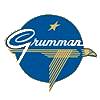
F9F-2 Panther
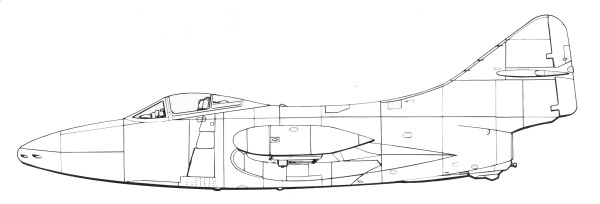
The F9F Panther was the manufacturer's first jet fighter and one of the United States Navy's first successful carrier-based jet fighters. A single-engine, straight-winged day fighter, it was armed with four 20 mm (0.79 in) cannon and could carry a wide assortment of air-to-ground munitions.
The Panther was used extensively by the U.S. Navy and Marine Corps in the Korean War. It was also the first jet aircraft used by the Blue Angels flight team, used by them from 1949 through late 1954. The aircraft was exported to Argentina and was the first jet used by the Argentine Naval Aviation.
Total F9F production was 1,382. The design evolved into the swept wing Grumman F9 Cougar.
The Grumman Panther was the primary U.S. Navy and USMC jet fighter and ground-attack aircraft in the Korean War. The Panther was the most widely used U.S. Navy jet fighter of the Korean War, flying 78,000 sorties and scoring the first air-to-air kill by the U.S. Navy in the war, the downing of a North Korean Yakovlev Yak-9 fighter. F9F-2s, F9F-3s and F9F-5s, as rugged attack aircraft, were able to sustain operations, even in the face of intense anti-aircraft fire. The pilots also appreciated the air conditioned cockpit, which was a welcome change from the humid environment of piston-powered aircraft.
Despite their relative slow speed, Panthers also managed to shoot down two Yak-9s and seven Mikoyan-Gurevich MiG-15s for the loss of two F9Fs. On 3 July 1950, Lieutenant, junior grade Leonard H. Plog of U.S. Navy's VF-51 flying an F9F-3 scored the first U.S. Navy air victory of the war by shooting down a Yak-9.
The first MiG-15 was downed on 9 November 1950 by Lieutenant Commander William (Bill) Amen of VF-111 "Sundowners" flying an F9F-2B. Two more MiG-15s were downed on 18 November 1950. The final four MiG-15s were downed on 18 November 1952 by Lt. Royce Williams of VF-781, flying off the USS Oriskany during a series of air strikes against the North Korean port of Hoeryong, right across the mouth of the Tumen River from the major Soviet base at Vladivostok. Williams' victories were notable because all four were flown by Soviet Naval Aviation pilots. In 1992, Russian authorities admitted that Captains Belyakov and Vandalov, and Lieutenants Pakhomkin and Tarshinov were lost on 18 November 1952. Information regarding this fight had been suppressed by the U.S. Navy at the time because personnel of the then-new National Security Agency had been involved in the intercept, and U.S. authorities were concerned that the Soviets might learn of this if the affair was publicized.
No other fighter pilot ever scored four MiG-15s in a single combat. Future astronaut Neil Armstrong flew the F9F extensively during the war, even ejecting from one of the aircraft when it was brought down by a wire strung across a valley, in 1951. Future astronaut John Glenn and Boston Red Sox all-star baseball player Ted Williams also flew the F9F as Marine Corps pilots.
Panthers were withdrawn from front-line service in 1956, but remained in training roles and with U.S. Naval Air Reserve and U.S. Marine Air Reserve units until 1958. The Navy's Blue Angels flight demonstration team used the Panther for four years, beginning in 1951. The Panther was the Blue Angels' first jet. Some Panthers continued to serve in small numbers into the 1960s.The Kit
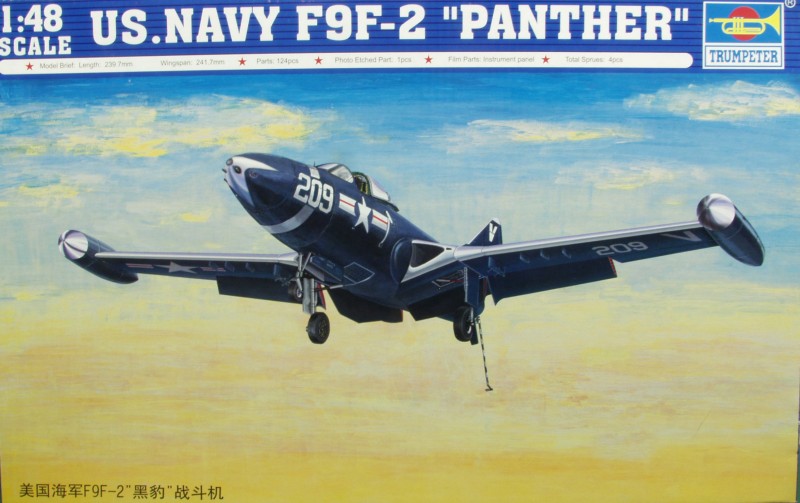
The Trumpeter kit comes in a tray type top open box made from thin corrugated cardboard. Inside the box all the sprues are individually bagged. The kit is molded in a light gray color and the finish is smooth and semi gloss. The surface detail consists of recessed panel lines and lots of recessed rivets and fasteners. Some will find the rivet detail over done but the panel lines are deeper than the rivets so one could sand it down to be rid of them. Personally I think under a coat of paint they will look OK. There is some flash but it is light and easy to remove. Mold parting line on parts like the gear struts is a little heavy but not as bad as limited run kits. I did not find any surface defects on my kit. The control surfaces are molded in the neutral position except for the flaps which are separate and can be positioned up or down. The speed brakes are also separate. Hopefully they will fit well in the closed position.
The cockpit is adequately detailed for the scale and should suit most modelers. The instrument panel is supplied as an unpainted photo etch part and a film is provided to place behind it for instrument detail. The cockpit tub side consoles have nicely raised detail. No belts or harness is supplied for the ejection seat. Two noses are supplied in the kit, one being a photo recon nose but no decals for that variant are supplied. The wings can be assembled folded if desired. The real aircraft's folding mechanism was sturdy enough to allow the wings to be folded with fuel in the tip tanks and armaments mounted on the wings.
The
nose gear is molded as part of a bulkhead and as such will need to be
installed prior to closing the fuselage. This always leads to issues
for me. The wheels are all molded one piece and have nicely detailed
hubs with the back side of the main gear wheels having brake detail.
No
need for after market here. The main gear struts feature some brake
line detail at the very bottom. There are holes that must be opened
for
munitions before the wings are assembled. A nice assortment of bombs
and rockets are supplied. Ejector pin marks are mostly where they
won't
be seen. Lets look at the sprues...
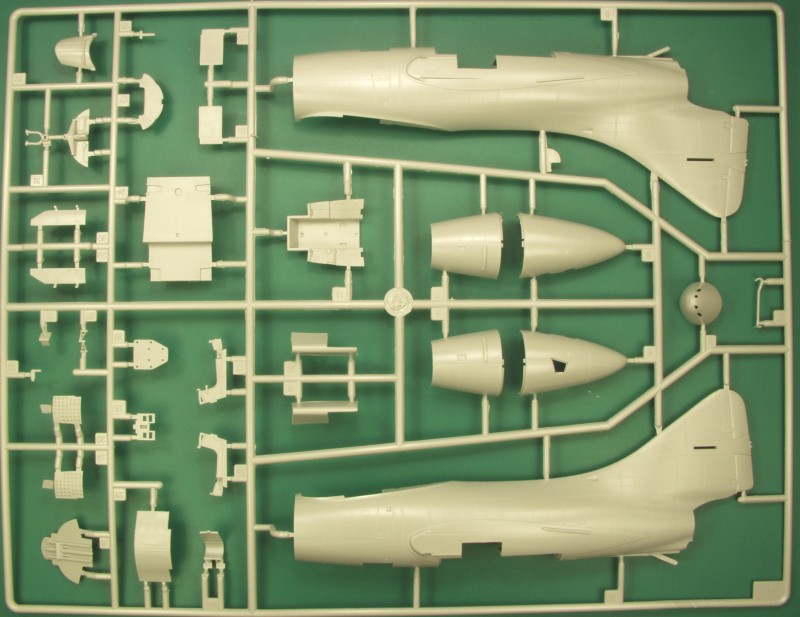
A close up up the cockpit tub.
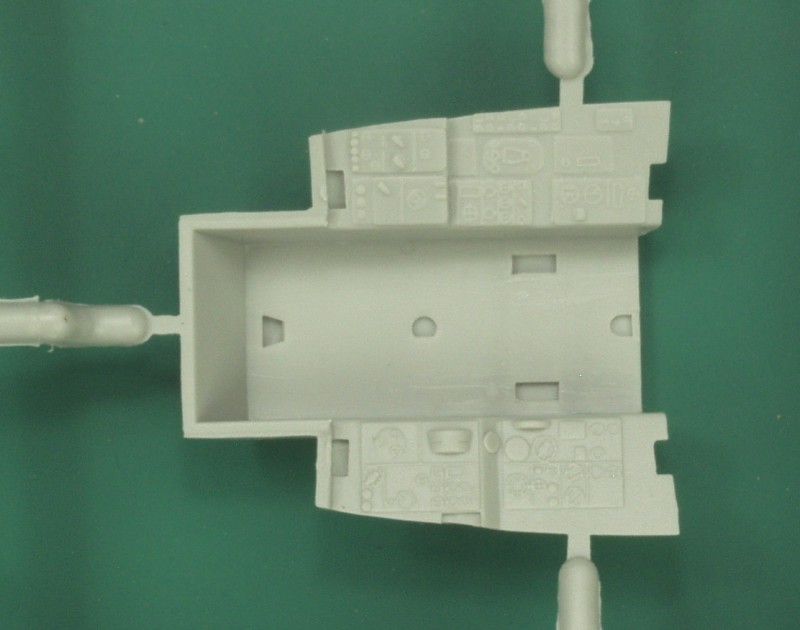
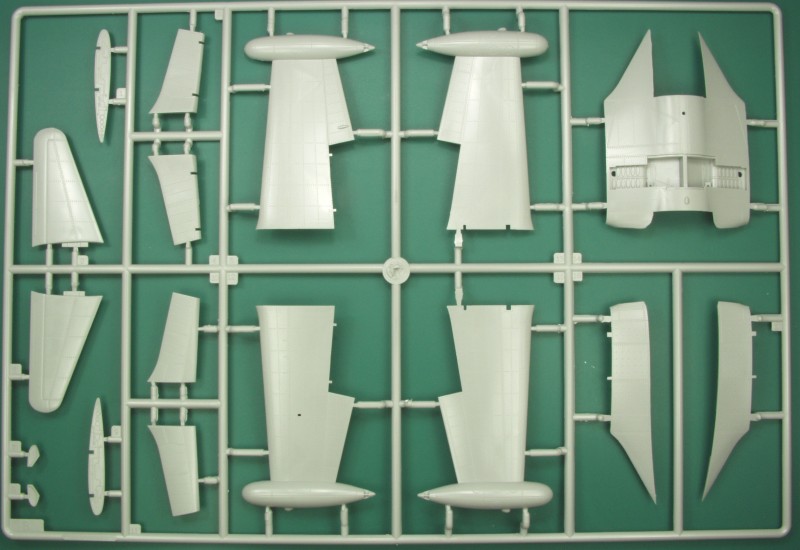
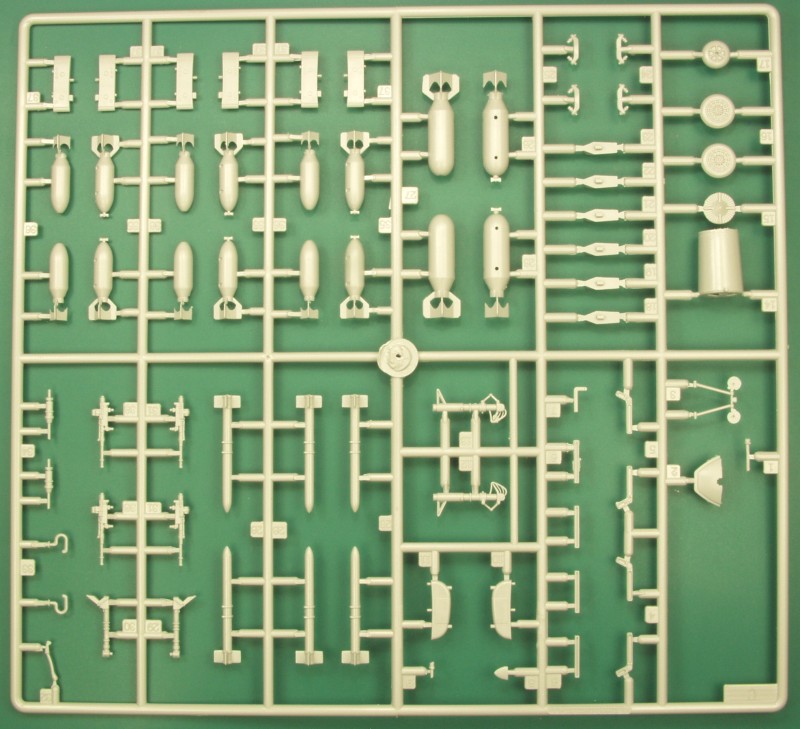
The clear parts are thin and quite clear but there is a bit of optical distortion in the very to of the canopy.
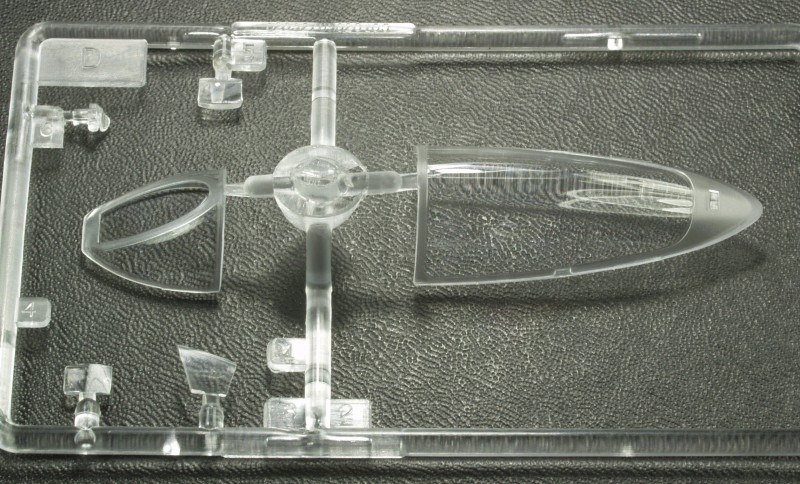
The decals are glossy and in register as much as they need to be. The color saturation looks good on the red items but the white looks to be way to translucent on the sheet. Other than the main markings no other stencil markings are supplied. Decals for three aircraft are supplied but no information about them other than what can be determined from the decal sheet itself. Two aircraft from VF 112 which vary only in aircraft number and mission markings and a third Vf -781 which apparently shot down a Mig as it has a Mig kill mark on the nose and some additional stripping. I have had mostly good luck with Trumpeter decals but I think I would test the white markings on a dark surface before using.
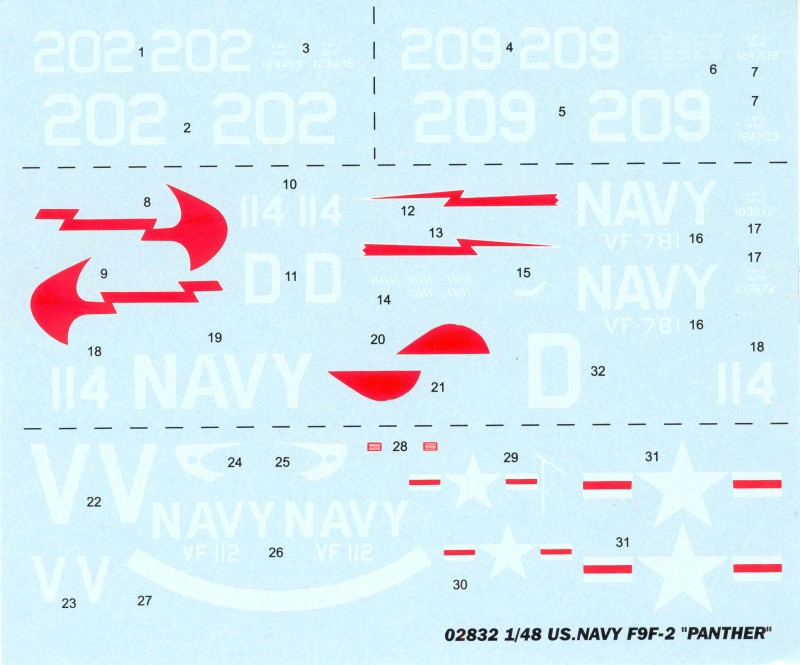
The instructions are typical or Trumpeter, an 8 page landscape format booklet stapled at the spine. The first page has general modeling and decal instructions and an icon chart. Page two has a parts map, the balance of the booklet is assembly diagrams. Painting and marking instructions are are on a separate glossy page printed on one side in color.
After Market Goodies
This was available so I went for it, mostly cockpit dress up stuff and it as the belts and harness that the kit lacks.
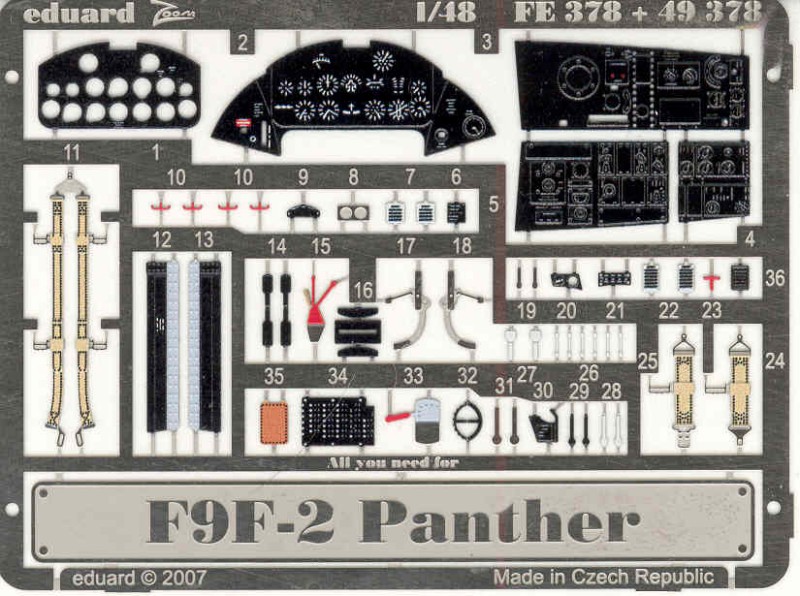
The next item I picked before seeing the kit, not sure it's worth the trouble as part of the nose needs to be cut away to use it and the only advantage over the kit part is the hollow ends on the gun barrels.
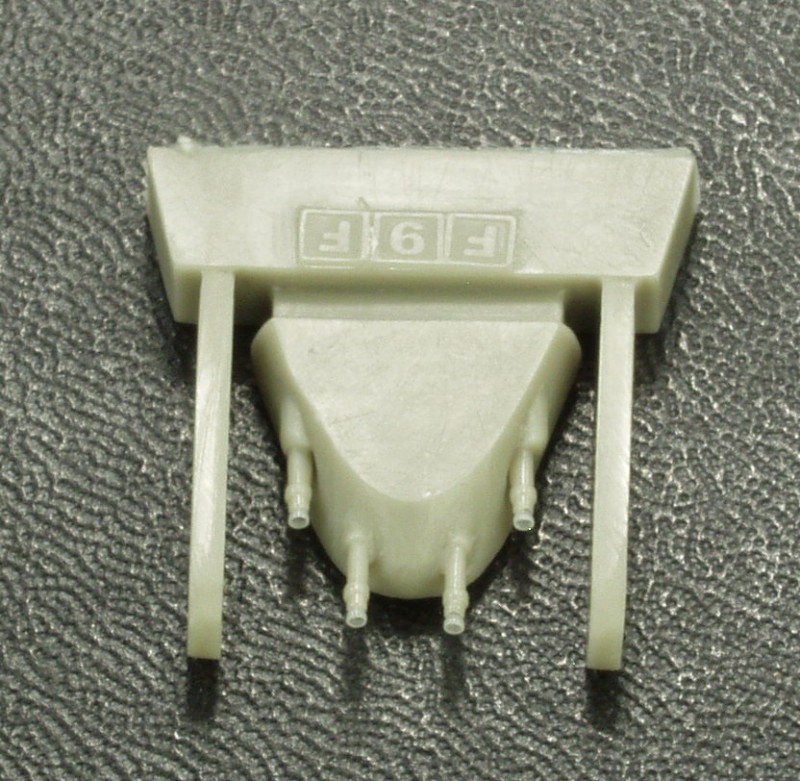
Conclusions
I have built a number of Trumpeter kits and found most to be enjoyable builds that go together well. Trumpeter does have a reputation for getting details wrong and I'm sure any Panther experts can point out some but it looks enough like a Panther to suit me. Some of the issues are described in the link below. Recommended for those with some experience.
Links to kit build or reviews
A build / review can be found here
References
F9F Panther & Cougar in Action by Jim Sullivan